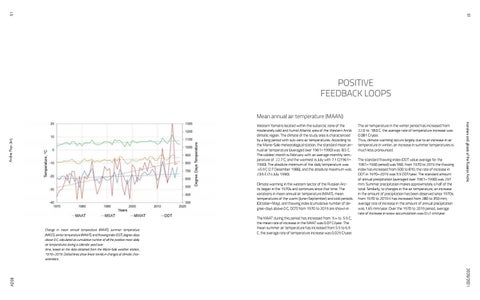51
51
POSITIVE FEEDBACK LOOPS Mean annual air temperature (MAAN)
Andra Pop-Jurj
Climate warming in the western sector of the Russian Arctic began in the 1970s and continues since that time. The variations in mean annual air temperature (MAAT), mean temperatures of the warm (June–September) and cold periods (October–May), and thawing index (cumulative number of degree-days above 0 C, DDT) from 1970 to 2019 are shown in
The standard thawing index (DDT value average for the 1961–1990 period) was 560; from 1970 to 2019 the thawing index has increased from 500 to 810; the rate of increase in DDT in 1970–2019 was 5.9 DDT/year. The standard amount of annual precipitation (averaged over 1961–1990) was 297 mm. Summer precipitation makes approximately a half of the total. Similarly, to changes in the air temperature, an increase in the amount of precipitation has been observed since 1970s: from 1970 to 2019 it has increased from 280 to 350 mm; average rate of increase in the amount of annual precipitation was 1.65 mm/year. Over the 1970 to 2019 period, average rate of increase in snow accumulation was 0.41 cm/year.
2020/2021
ADS8
Change in mean annual temperature (MAAT), summer temperature (MAST), winter temperature (MAWT), and thawing index (DDT, degree-days above 0 C, calculated as cumulative number of all the positive mean daily air temperatures during a calendar year) over time, based on the data obtained from the Marre-Sale weather station, 1970–2019. Dotted lines show linear trends in changes of climatic characteristics.
The MAAT during this period has increased from 9.4 to 5.9 C, the mean rate of increase in the MAAT was 0.07 C/year. The mean summer air temperature has increased from 5.5 to 6.9 C, the average rate of temperature increase was 0.029 C/year.
The air temperature in the winter period has increased from 22.0 to 18.0 C, the average rate of temperature increase was 0.081 C/year. Thus, climate warming occurs largely due to an increase in air temperature in winter; an increase in summer temperatures is much less pronounced.
monsters and ghosts of the Russian Arctic
Western Yamal is located within the subarctic zone of the moderately cold and humid Atlantic area of the Western Arctic climatic region. The climate of the study area is characterized by a long period with sub-zero air temperatures. According to the Marre-Sale meteorological station, the standard mean annual air temperature (averaged over 1961–1990) was 8.5 C. The coldest month is February with an average monthly temperature of 22.7 C, and the warmest is July with 7.1 C(1961– 1990). The absolute minimum of the daily temperature was 45.9 C (27 December 1986), and the absolute maximum was 23.6 C (14 July 1990).






















